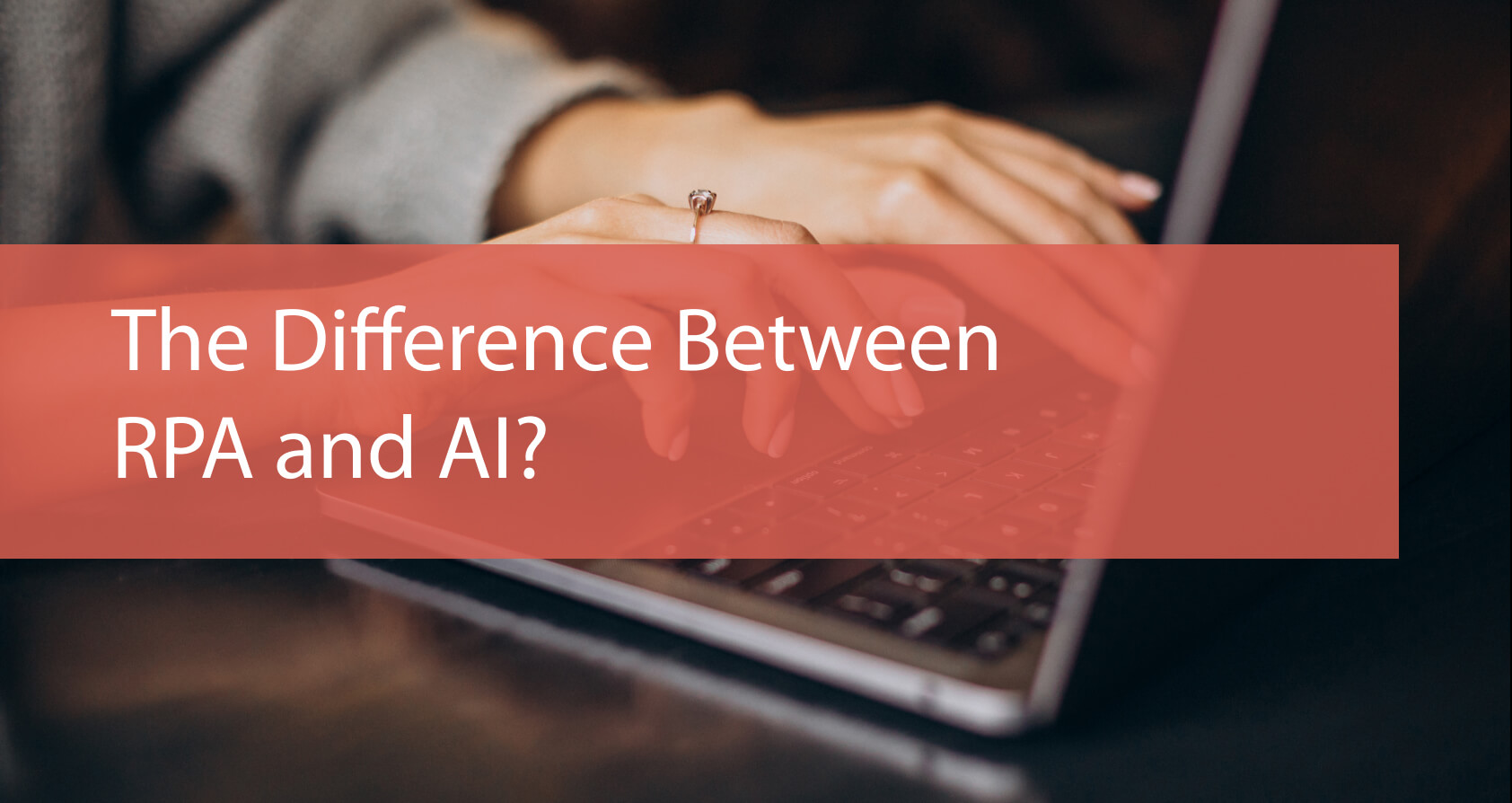
The Difference Between Robotic Process Automation and AI: Which is Right for You?
RPA and AI are distinct and co-evolving technologies. RPA uses software robots to mimic and execute repetitive, rule-based tasks that don’t require human intelligence, while AI enables machines to mimic and perform cognitive functions with human-like intelligence. Discover more differences between RPA and AI, their use cases, and which one is right for you.
Robotic process automation (RPA) and artificial intelligence (AI) are two of the most talked-about technologies.
Companies use RPA and AI to build intelligent applications and machines while discovering new opportunities through the connection between them. In fact, a Deloitte study found that 47% of businesses have already tapped into their immense potential.
RPA and AI create a truly digital workforce that drives never-before-seen gains in efficiency, productivity, and customer satisfaction when used in tandem.
While these terms dominate business dialogues worldwide, they overlap and are easily misunderstood.
To help you understand RPA and AI, this guide will define both terms, explain their differences, and help you determine which one is right for your business.
What is Robotic Process Automation?
RPA is an automation technology that uses software robots, or “bots,” to perform and complete rote, repetitive, and non-value-added tasks like extracting data or filling forms.
In the back office, for example, bots relieve humans of rule-based processes such as sales quotes, invoicing, tax processing, and more. Employees can focus more on higher-value work that they do best and enjoy more.
Your business also gets a boost with benefits such as:
- Higher productivity and efficiency: RPA improves many processes in your business, yielding higher capacity, efficiency, and faster throughput.
- Better customer experience: When your employees are engaged, they’re committed to their work and act positively in their roles, leading to better interactions with customers.
- Fewer or no errors for key processes: RPA bots are impervious to human error. Once trained, they speed up end-to-end processing, executing key operations with 100% precision and improving consistency.
- Minimal upfront spending: RPA is often cheaper to deploy and more flexible when conditions change compared to enterprise technologies like ERPs, CRMs, and application programming interfaces (APIs).
- Little disruption to existing systems: Software robots can access and work with little disruption in legacy systems, which are otherwise difficult to integrate.
- Rapid return on investment (ROI): RPA is a low-cost solution whose bots don’t require code and are easy to deploy quickly, delivering rapid and substantial payoffs between 30% and 200% in the first year.
- Business scalability: Bots make it simple for businesses to scale up or down and easily accommodate seasonal workflows and/or demand spikes.

Where is RPA Used?
In factories and manufacturing organizations, robots have been improving productivity, efficiency, and workplace satisfaction as they free employees from repetitive work.
And now—thanks to RPA—companies can access that same level of productivity increase and benefit from implementing RPA tools in rule-based, non-subjective processes across different departments.
RPA drives new efficiencies in a broad swath of processes and different industries.
Companies in everything from financial services to retail to manufacturing to healthcare and beyond have implemented RPA in diverse areas, including legal, customer service, finance, operations, IT, and compliance.
Here are some RPA use case examples that amplify the power of automation in various business processes.
Financial Services and Banking
Financial institutions have been grappling with several significant challenges—key among them compliance—whose costs have increased by more than 60%.
With the current increasing economic uncertainty, major changes in the financial services industry are taking place around regulation, ethical and responsible practices, and customer interaction.
It’s normal to hire when such difficulties arise, but bringing on new employees doesn’t resolve the heart of the problem.
To maintain industry-wide integrity, financial institutions must adhere to the intensified regulatory requirements or incur fines and penalties for noncompliance.
RPA helps financial institutions thrive in the modern age by:
- Automating unstructured data, which is crucial for creating strong customer experiences and delivering documents promptly. This includes information such as customer details (identity, proof of address), tax returns, wire instructions or chats, payments, emails, documents, PDFs, forms, and more.
- Empowering customer-facing functions—especially onboarding and financial advising—such as Know Your Customer (KYC), control testing, mortgage remediation, regulatory reporting operations, and AML teams.
- Handling semi- and unstructured data inputs, exceptions, dispute and alerts management, risk approvals, and other complex processes.
Automation is crucial for financial institutions to stop wasting resources on compliance demands, reduce risk exposure, increase operational efficiencies, and scale for long-term prosperity.
Healthcare
Gartner predicts that 50% of U.S. healthcare providers will use RPA, up from 5% in 2020, resulting from the need to optimize costs and scarce resources.
Enrolling and onboarding, billing, administering claims, improving HR and legal compliance, and other routine activities make up 33% of healthcare tasks that bots can automate.
RPA helps healthcare organizations:
- Handle repetitive, mundane tasks so healthcare professionals can spend more time providing efficient and more personalized services to patients—not paperwork.
- Get the data and time they need to provide better patient services like appointment scheduling, triage, treatments, billing, and more.
- Increase process speed and accuracy, ensuring compliance with regulatory requirements and reducing operational costs.
- Speed up claims and payment processing accurately while generating reports for easier analysis and decision-making.

Manufacturing
Without software robot assistance, it’ll be difficult to keep the many pieces of a manufacturing process moving swiftly, leading to downtime, machine failures, and revenue loss.
Senseye’s survey of Fortune Global 500 manufacturing and industrial companies found that they lose:
- Nearly $1 trillion a year due to unplanned downtime ($532,000 per hour or $172 million per plant)
- 3.3 million hours of production time annually to machine failures
- Up to 8% of annual revenues
RPA helps manufacturers prepare for and react to unexpected risks by:
- Automating research and development (R&D) operations to drive product innovation.
- Ensuring a smooth flow of insight, data, and actions across the supply chain.
- Increasing accuracy and timeliness of demand planning to get products where they need to be faster.
- Keeping service lines efficient to improve the quality and responsiveness of customer service and maintenance.
- Streamlining core business processes to improve employee productivity with less stress.
Read our RPA for Manufacturing guide to learn more about how automation enables digital transformation initiatives within the industry.
Retail
In the past few years, retail and consumer packaged goods (CPG) companies have been in a tough spot.
Rising production costs, labor gaps, rapidly changing customer expectations, and disruptions in the supply chain affected demand, supply, material planning, deployment, and logistics functions.
In such a dynamic environment shaped by squeezing pressures, retail and CPG leaders are innovating with RPA from the retail supply chain through to the back office and out onto the shop floor.
Retailers and CPG companies use RPA to:
- Automate demand and supply planning to increase capacity and asset management while improving customer, supplier, and employee satisfaction.
- Improve communications by alerting suppliers and customers about order bookings, shipping, deliveries, or delays.
- Monitor and maintain inventory levels while generating stock level notifications to ensure there’s enough stock to meet consumer demand.
- Assess past orders to determine optimum order levels and improve the procurement process.
- Check orders against customer databases and other records in case of any suspicious orders.
- Manage the source-to-pay process from product sourcing to continually monitoring contracts and supplier performance.
- Quickly and effectively handle customer complaints to turn disgruntled customers into loyal brand advocates.
- Transform and streamline the manual, time-consuming returns processing task into an automated service that gives retailers a competitive edge and builds customer loyalty.
Types of Processes Suitable for RPA
Implementing a successful RPA program that delivers a high ROI starts with identifying the processes best suited for automation.
Software bots mimic tasks humans usually perform, deciding on predefined rules and executing the work quickly, without errors.
These robot-like characteristics make them helpful for processes in multiple, disparate IT systems that are:
- Rule-based: RPA bots work in logical systems or programs that use predefined, human-made rules to store, sort, and manipulate data. They follow the “if X (trigger) happens, then do Y (specified action)” rule to make deductions and choices, and perform automated actions like generating and processing invoices or sending automated messages to customers and suppliers.
- High-volume: Software robots can work 24/7/365 to address high-volume tasks or transactions such as orders, requests, and complaints quickly and accurately without human involvement.
- Handled manually: Manual, tedious, time-consuming tasks that are highly dependent on human actions, and impacted by changes in transactional demand, are suitable candidates for automation. Examples include entering customer details into a database, data migration, or order and claims processing. Automating such processes means faster execution, fewer human errors, and workers can focus on more productive work.
- Highly organized: RPA technology works well with predictable and structured data, typically in a spreadsheet with rows and columns or database in tasks such as data entry and extraction. Each piece of data can be mapped to a specific, fixed location or field and used to help fill forms, generate and cross-check invoices, and execute other operational tasks.
- Disparate: RPA can manipulate user interfaces and bridge disparate systems that don’t communicate with each other. For example, if your sales team manually checks your CRM to transfer client information to the ERP system, RPA bots can automate this data transfer process with 100% accuracy.
- Standardized and stable: Highly definable, consistent, and data-driven tasks that happen in the front office or back office are automatable. These include tasks like claims processing, account opening, transaction duplication, customer service, and sales support.
- Difficult to outsource: RPA allows businesses to control the execution of transactions and other activities that require high levels of regulatory compliance. Bots keep an audit trail of their actions, which you can monitor and review later for any exceptions or anomalies.
Examples of RPA in Action
According to Deloitte, 78% of business leaders are already automating RPA in their organizations. Here are some success stories of organizations implementing RPA across various business functions.
Financial Services and Banking
İşbank, the biggest private bank in Turkey, implemented RPA to improve efficiency and make employees fulfill their potential.
The bank deployed software robots in their operation centers, where 1,500 employees handled repetitive tasks every day, and gradually expanded automation to processes in their branches and headquarters.
Today, almost 70 bots do the work of about 300 full-time employees (FTEs). The bank has seen more substantial changes, including more reskilled employees doing more rewarding work, higher efficiency, and better workplace culture.
Healthcare
To reduce the administrative burden on its healthcare professionals, Helse Vest deployed RPA across five health trusts they manage in West Norwegian counties.
Today, the health authority’s doctors and nurses no longer waste time doing double and triple registration of patient information.
RPA automates the 10-minute manual registration process and completes it in two minutes, giving health professionals more time with patients. Plus, they have access to accurate, high-quality data, which improves the quality of care and treatment.
Retail
Leading denim brand, Levi Strauss & Co., uses RPA to enable its workers to spend more time on higher-level tasks that require human intelligence.
The company’s software bots handle repetitive tasks in the wholesale invoicing process, saving more than 500 hours of work while reducing operational costs and improving their invoice tracking management.
Levi’s merchandise coordinators no longer enter product codes manually. Automated bots complete in 20 seconds what employees take more than five minutes to do. RPA saved the company nearly 750 hours, giving its employees more time to reskill and pursue more rewarding work.
So far, Levi’s has a pipeline of about 50 new bots in the purchase order and other processes, which is predicted to save workers more than 20,000 hours annually.

Artificial Intelligence
Artificial intelligence, or AI, is a catchall term for systems or machines that work together to execute complex tasks with human-like levels of intelligence.
AI is often used interchangeably with machine learning (ML) and deep learning. However, the latter are AI subfields, which build systems that learn or improve performance based on large amounts of data.
Unlike RPA, which uses software robots to learn, mimic, and execute rule-based processes on computers, AI uses robust data sets and computer science, allowing a computer to mimic human cognitive functions such as learning and problem-solving.
For example, a chatbot uses AI to understand and provide responses to customer problems quickly and efficiently, while recommendation engines in a media streaming service like Netflix offer automated recommendations for movies or TV shows based on users’ viewing habits.
AI machines or systems can iteratively improve themselves using math and logic to simulate reasoning based on the information they collect. They’re more about the process and capability for intelligent thinking and analysis than RPA, which is about a particular format and function.
AI covers a wide range of use cases, especially business areas that traditionally provide the most value, such as:
- Providing chat-based support to respond to queries and complaints and improve customer satisfaction.
- Analyzing and understanding unstructured data in emails, documents, support tickets, and customer feedback interactions to increase efficiency and improve the customer experience.
- Extracting data from scanned documents and images to sort, classify, upload to a database, and retrieve for use across the organization.
- Detecting anomalies to ensure optimal operations, reduce production management work, and avoid excess costs.
- Gauging internal compliance when using approved vendors.
For example, retail organizations can use AI on customer data to personalize promotions or deliver personalized recommendations across the sales funnel, fulfilling shoppers’ needs and increasing sales.
For manufacturers, AI in advanced operations enables forecasting based on-demand drivers while improving forecasting accuracy. This leads to lower increased cost savings and revenue.
Hospitals and other healthcare organizations are also using AI to identify and treat patients at the highest risk of dangers, such as sepsis and impending stroke or cardiac arrest, in their ERs, ICUs, and inpatient wards. AI algorithms process large amounts of data in electronic health records (EHRs) to:
- Find patterns, predict future outcomes, and recommend treatments.
- Create early warning systems for healthcare professionals to identify subtle yet serious changes in a patient’s condition that may not easily be spotted in busy units.
- Predict patients who are about to be discharged and those who are at the highest risk of readmission.

Combining Artificial Intelligence and Robotic Process Automation
RPA and AI differ in form and function.
However, both technologies work best in tandem—AI needs RPA to deliver at its full potential, but together create an intelligent automation solution with almost limitless potential.
AI builds on the capacity of software robots, transforming them from mere bots that execute repetitive, rule-based tasks to supercharged, intelligent bots with:
- Image and speech recognition capabilities.
- Ability to understand and process unstructured data.
- Ability to apply ML models and natural language processing (NLP).
Take, for example, Bank of America (BoA), which deployed Erica, an AI-powered virtual assistant (VA), to respond to their banking-related queries, help customers check their account balances, and remind them about bill payments.
The bank expanded Erica’s AI capabilities to include insights, meaning customers could access the VA for reliable information and customized recommendations on the go based on their banking behavior.
Within a few months, BoA increased its customers from 7 to 10 million.
Deutsche Bank also deployed attended RPA and unattended IA to integrate its own systems with third-party systems and expedite document custody procedures.
RPA and AI halved the time the bank took to screen customers as part of its KYC process, freeing employees up to focus on higher-value functions. Through automated data harvesting, the bank saved millions of euros in costs, which would otherwise have been spent hiring workers to do the same job.
Fraud prevention teams can also benefit from the combination of RPA and AI when they come across suspicious orders. RPA bots investigate the order by checking it against company records and customer databases, while AI processing identifies any fraud-related discrepancies in the order.
But RPA and AI don’t always work together, especially where:
- The process is ambiguous or not well understood.
- Employees lack the skills and knowledge to manage the tools.
- Teams refuse to work together due to department silos or other internal issues.
- There are inefficient business systems and processes.
Some common remedies for these challenges include:
- Retraining employees on RPA and AI.
- Partnering with a Process as a Service (PaaS) vendor to run and manage the automation.
- Using process mining to map processes before embarking on an IA implementation.
How to Know if Your Organization Needs RPA or AI
Choosing whether to use RPA, AI, or both is half the battle.
So, how do you know when to implement both technologies in your organization?
The easiest way is to start your automation journey using task mining to discover automation possibilities for individual workflows.
Once you know what to automate, add AI to processes that are too complex for RPA alone, which rely on:
- Unstructured data:images, documents, handwritten notes, emails, support tickets, and customer feedback interactions.
- Lots of variables: resolving claims, resume reviews, or purchase decisions.
- Uncertain outcomes: demand or supply forecasts, loan defaults, or mortgage underwriting.
Knowing when to use RPA or RPA plus AI makes it easier for your automation team to plan resources, prioritize automation use cases, and budget for the process.
Implementing RPA in Your Company
Choosing between RPA and AI starts with identifying the root of the business problem and working your way back.
The focus shouldn’t be on RPA vs. AI but on the specific use cases, benefits, and how to leverage both to achieve greater efficiency, higher productivity levels, improve customer satisfaction, and increase revenues.
Contact Leaniar to find out how you can implement RPA and AI, enhance your processes and strengthen your business
